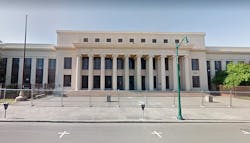After a $60 million makeover, Historic Alameda High School in Alameda, Calif., is returning to its original use after more than four decades: Educating high school students.
The San Jose Mercury News reports that the Alameda Unified District is commemorating the restoration with a ribbon-cutting and tours. Students will arrive for the first day of school on Aug. 19.
The building, which was added to the National Register of Historic Places in 1977, ceased operations as a high school in 1978 when a new campus was constructed nearby. In the intervening years, the old facility has housed the district central office, the Alameda Adult School, and the Alameda Free Library. The building has been vacant since the district office moved out in 2012.
The work to modernize the school and make it earthquake-safe began in April 2017. Workers have removed 2.4 million pounds of concrete and 900,000 pounds of wood, and installed 1.2 millions pounds of steel, 19 miles of conduit and wiring, 6,000 panes of glass and five miles of copper and steel piping.
The facade of the Neoclassical revival-style building constructed in 1924 has its original cream and white color back.
“It has been restored to its former grandeur,” District spokeswoman Susan Davis says. “It’s really a majestic building.”
The restoration means Alameda High's 1,800 or so students will attend most classes this fall in the old school, moving from the newer campus building just behind it.
The 100,000-square-foot Historic Alameda High School complex actually consists of three buildings.
The main building, made up of two wings of classrooms and an auditorium, was constructed in 1924. The science building was added 10 years later, and the west wing was built in 1957. All three buildings have been upgraded.
The upgrade modernized 37 classrooms; 11 science labs were created, and a half-dozen meeting rooms were built.
Along with restoring the main lobby, upgrades include new electrical and fire sprinkler systems, as well as repairing the outside terrazzo stairs.
Money from Measure I, a $179.5 million bond proposal approved in November 2014, paid for much of the current restoration. The rest of the money came from state matching grants for seismic improvements, the district’s deferred maintenance fund and Proposition 39 allocations for energy efficiency improvements.
About the Author
Mike Kennedy
Senior Editor
Mike Kennedy, senior editor, has written for AS&U on a wide range of educational issues since 1999.
